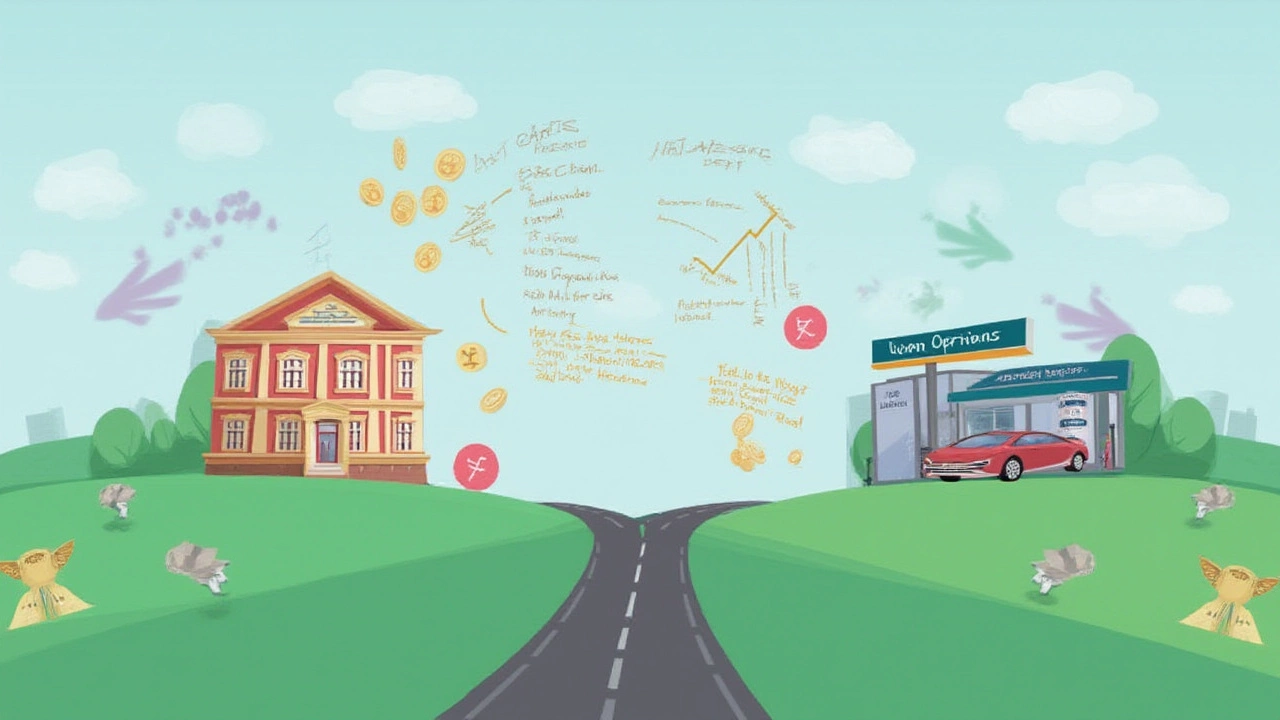If you’ve ever dreamed of that new-car smell—leather seats, shiny dashboard, your playlist on the stereo—financing through your bank probably wasn’t the first thing that popped into your head. Yet, where you get your car loan can make or break your finances for years. The world of auto loans is more complicated than scrolling through car photos online, and if you’re not careful, you can pay way more than you bargained for. Should you just take whatever the dealer offers, or march straight into your bank with your paperwork? It’s not just about getting approved, it’s about how the decision follows you home. Let’s peel back every layer—fees, interest rates, approval speed, and those sneaky little terms that get glossed over in the showroom.
The Real Differences Between Bank Financing and Dealership Loans
Car buyers run into two main roads: you get a loan from your bank or credit union, or you let the dealership handle it. On paper, these look almost the same—monthly payments, interest, you drive home in style. In reality, though, there are big differences that matter for your wallet, and some aren’t as obvious as they seem.
First off, bank auto loans usually mean you walk into the dealership as a “cash buyer.” This gives you bargaining power. Dealers sometimes push low rates—like those "0% financing for 36 months" ads—but that's often reserved for people with top-tier credit, and not all car models qualify. Banks and credit unions tend to offer more transparent rates based directly on your credit score, not on which car model you want or what promotion is running. This means you get the same rate whether you want a practical sedan or an impractical sports car.
Dealers play middleman with their loans. They often work with multiple lenders, but here’s the catch: they can tack on extra percentage points to whatever rate the bank or finance company offers, pocketing the markup as "dealer reserve." This can mean hundreds, sometimes thousands, extra over the life of your loan. According to a 2023 Consumer Financial Protection Bureau report, the typical markup on dealer-arranged financing added between 1% to 2% to rates, costing Americans over $1 billion a year in unnecessary interest. Most buyers never realize this markup is negotiable.
Your bank, however, usually skips those add-ons. But that doesn't mean it's always a slam dunk. Banks may have stricter requirements, take longer to process your application, and ask for more documentation upfront. If you’re buying a used car, banks sometimes put age or mileage limits on what they’ll finance. In contrast, dealers can be more flexible, especially if you have less-than-perfect credit—but that flexibility can come with higher rates or hidden fees.
Another point: Banks don’t just hand you a blank check. You usually get approved for a maximum amount, and then you negotiate the car price. At the dealership, finance managers might try to focus you on “the monthly payment” rather than the total cost. Don't fall for this trap; extending the loan term to lower the payment can mean you pay much more over time, even if you don’t notice day to day.
Let’s talk speed and convenience. The average bank or credit union might take a couple of days to process, while a dealer can get you in and out in a few hours. This rush is great if you’re impatient, but do you want to sign up for years of payments just to save a single afternoon?
Many buyers don’t realize that banks and credit unions sometimes have “relationship discounts” for their customers. That’s the little-known trick: if you already bank there, ask if they offer loyalty perks that knock a quarter point off your rate, or even waive processing fees. Some will pre-approve you online, so you can shop with confidence and walk away if the dealership starts playing games.
You also want to keep an eye on add-on products like extended warranties, GAP insurance, or paint protections. These are the upsell playgrounds at dealerships, but if you finance through a bank, you’re usually only dealing with the loan. That separation can save you from impulsive, costly add-ons.
Still, every situation is different. If you have excellent credit, the best bank deals might beat dealer offers handedly. But if your credit’s on the rough side, the dealership could have more lender options, at a higher cost. Figuring out your best move means running the real numbers, not just taking the salesperson’s word for it.

Busting Myths and Hidden Pitfalls in Car Financing
There’s a lot of folklore in car buying. “Dealers get you the best deals!” “Banks are slow and old-fashioned!” Reality is more nuanced, and getting it wrong can mean years of overpaying. Let’s lay out what you’re actually facing, including some mistakes people make that you’ll definitely want to avoid.
Myth: Dealer financing is always faster. Sure, their finance office can blast out approvals in minutes. But speedy doesn’t always equal better. Dealers are incentivized to upsell you on packages and products while you’re there, and you might make emotional decisions because you want to drive off today. One survey from LendingTree revealed that buyers who took their time and shopped around for a loan ended up with APRs about 1% lower, on average, than those who signed on the spot at the dealership.
Myth: Bank rates and dealer rates are worlds apart. Actually, this gap has shrunk in the last decade. Banks are competing heavily for loan business, and some smaller credit unions regularly offer rates below national banks. However, watch out for “teaser” rates—those ultra-low offers only a tiny sliver of buyers will actually qualify for.
Warning sign: Don’t focus solely on monthly payment. It’s the classic tactic—spread the payments over six or seven years, and that pricey car suddenly looks affordable. Except you’re now paying a fortune in extra interest. According to Experian’s 2024 Automotive Finance report, the average new car loan was $40,841 with a term of 69 months. Stretching to 84 months (that’s seven years!) means you could pay thousands more. Shorter terms mean higher monthly payments but much less interest in the long run.
People also overlook the impact of “prepayment penalties.” With some dealer-arranged loans, trying to pay the loan off early can trigger hefty fees. Most mainstream banks and credit unions don’t charge these, but always double-check the fine print before signing.
Rolling negative equity into a new loan is another trouble spot. If you owe more on your current car than it’s worth, dealers might happily “roll it in”—but now you owe even more on your next car, raising both your loan balance and your risk of being underwater if disaster strikes.
Score anxiety is real, but here’s a tip: When shopping for rates, multiple inquiries within a two-week period are counted as a single hit on your credit score. So don’t be afraid to shop banks, credit unions, and even dealerships for quotes. Just do it efficiently, not over several months.
An extra perk with bank financing? If you get pre-approved, you’ve just set a clear spending limit for yourself before you even start negotiating. It’s the best way to avoid “upsell creep”—the slow, sneaky climb in both car price and extras that happens when you haven’t locked yourself to a number.
Bottom line: there’s no universal answer, but misinformation costs more than you think. Savvy car buyers don’t just focus on who can get them a quick signature—they look at who can get them the best long-term deal.

How to Choose What’s Best: Practical Steps and Expert Tips
So, how do you actually decide whether to finance through your bank or dealership? It’s about research, confidence, and refusing to get rushed.
Start by checking your credit report and score before anything else. Knowing your score arms you for negotiations and helps predict which rates you’ll realistically see. Sites like AnnualCreditReport.com let you check your report free each year. If your score’s 700 or above, you’re looking at some of the best possible rates; under 600, and you might struggle to qualify with a bank—and dealers will likely offer higher terms. Consider improving your score before applying if you’re not quite where you want to be.
Next, shop around. Don’t just walk into your bank without scoping out what’s available from other lenders and dealership lenders. Use online loan comparison sites, your own bank, and at least one local credit union. Sometimes, credit unions offer rates a half point lower than national banks. Remember those “relationship discounts”—they’re real, and banks rarely advertise them. Ask about autopay discounts, or if existing account holders get special pricing.
When you apply for pre-approval, banks usually give you a set amount for a certain period (often 30-60 days). This is your shopping ticket—bring it to the dealership and focus your negotiation on the out-the-door price, not just the payment. If the dealer offers a better rate in writing, use your pre-approval as leverage—they might try to match or beat it.
Look out for the total loan cost. Don’t get distracted by the monthly payment game. Insist on seeing the full cost of the loan—total amount financed, total interest paid, and the annual percentage rate (APR). APR includes all required fees and gives you the real cost in a single number. If a dealership won’t show you APR or tries to shift back to “monthly payment,” take that as a red flag.
Always read the contract, and don’t sign anything you don’t understand. Banks usually give you more time to review contracts, without the pressure-cooker feel of a dealership closing room. If the dealer starts loading in extra “protection packages,” ask for a line-item breakdown or, better yet, politely decline and see what happens to your payment.
Some people benefit from talking to someone at their bank or credit union face-to-face, especially if you’ve had credit hiccups in the past. Explain your situation honestly—banks sometimes have more flexibility than a faceless online lender, and they’re often willing to work with long-standing customers.
- Check multiple financing offers within a 14-day window to minimize credit score impact.
- Get pre-approved from at least your primary bank and a credit union.
- Aim for a loan term of no more than 60 months to save on interest.
- Skip unnecessary add-ons unless they’re a must-have for you.
- Know your car’s true market value before financing—sites like Kelley Blue Book are your friend.
- Insist on seeing the APR and total loan cost—not just the monthly payment.
- Don’t be afraid to walk away—sometimes, this is when dealers miraculously find "a better rate."
It’s a myth that only the desperate finance their cars. Even people with the cash to buy outright sometimes choose to finance at a low rate, investing their money elsewhere. But when it comes to choosing between your bank and the dealer, use your leverage: walk in prepared, compare like-for-like, and make sure you’re getting the best deal for the car finance that fits your life—not just the first one that lets you drive home with new wheels.
